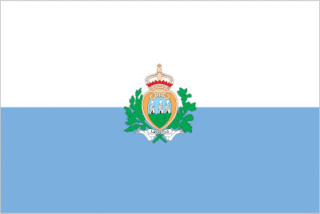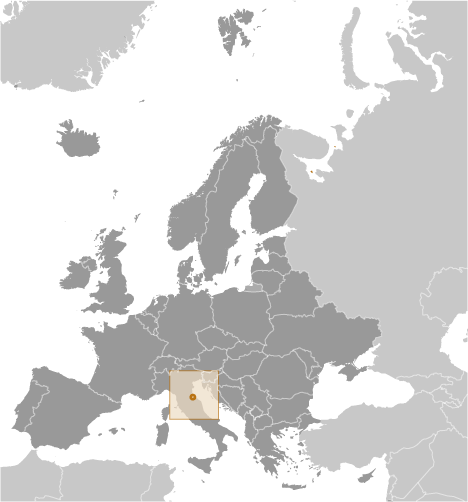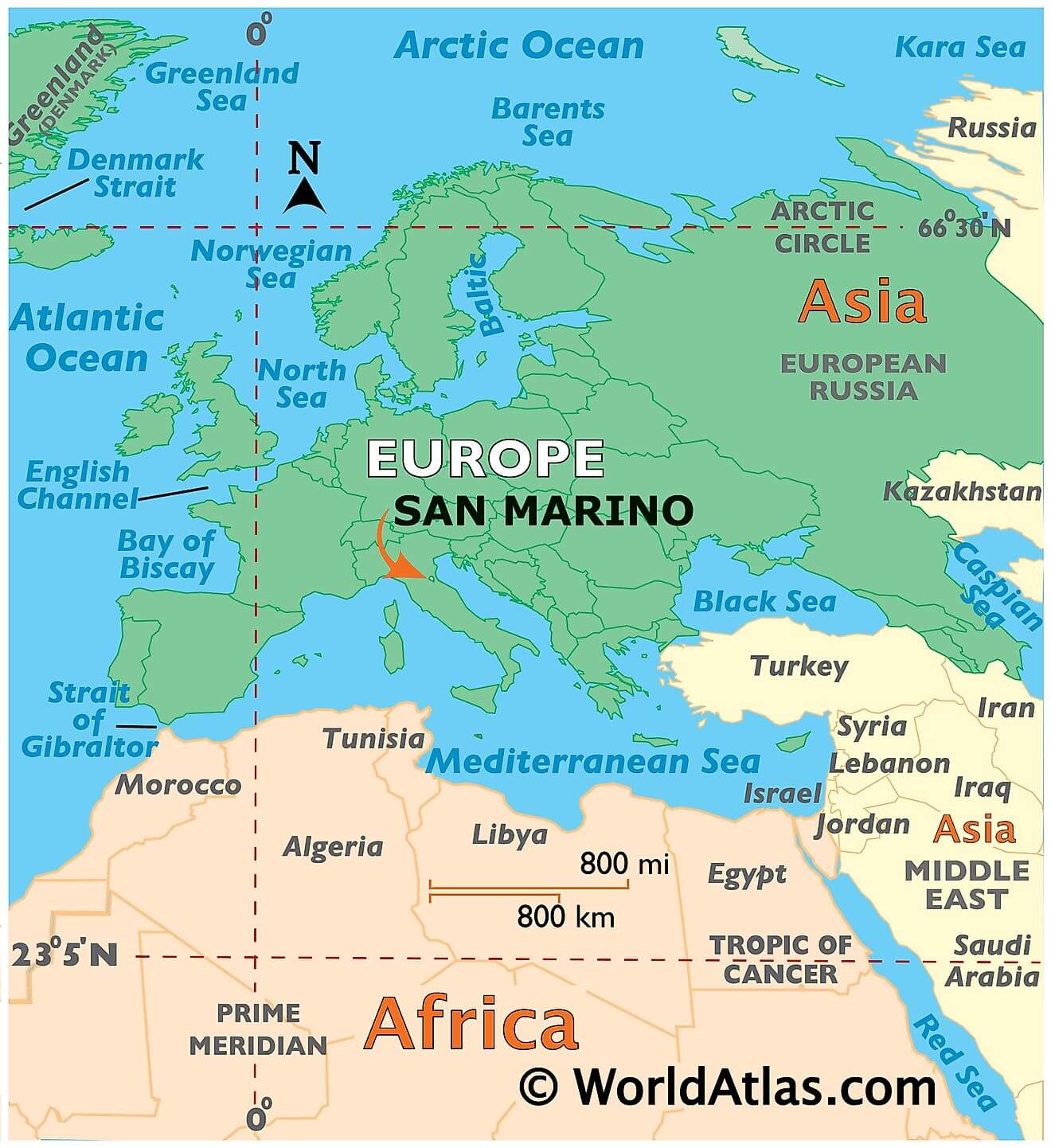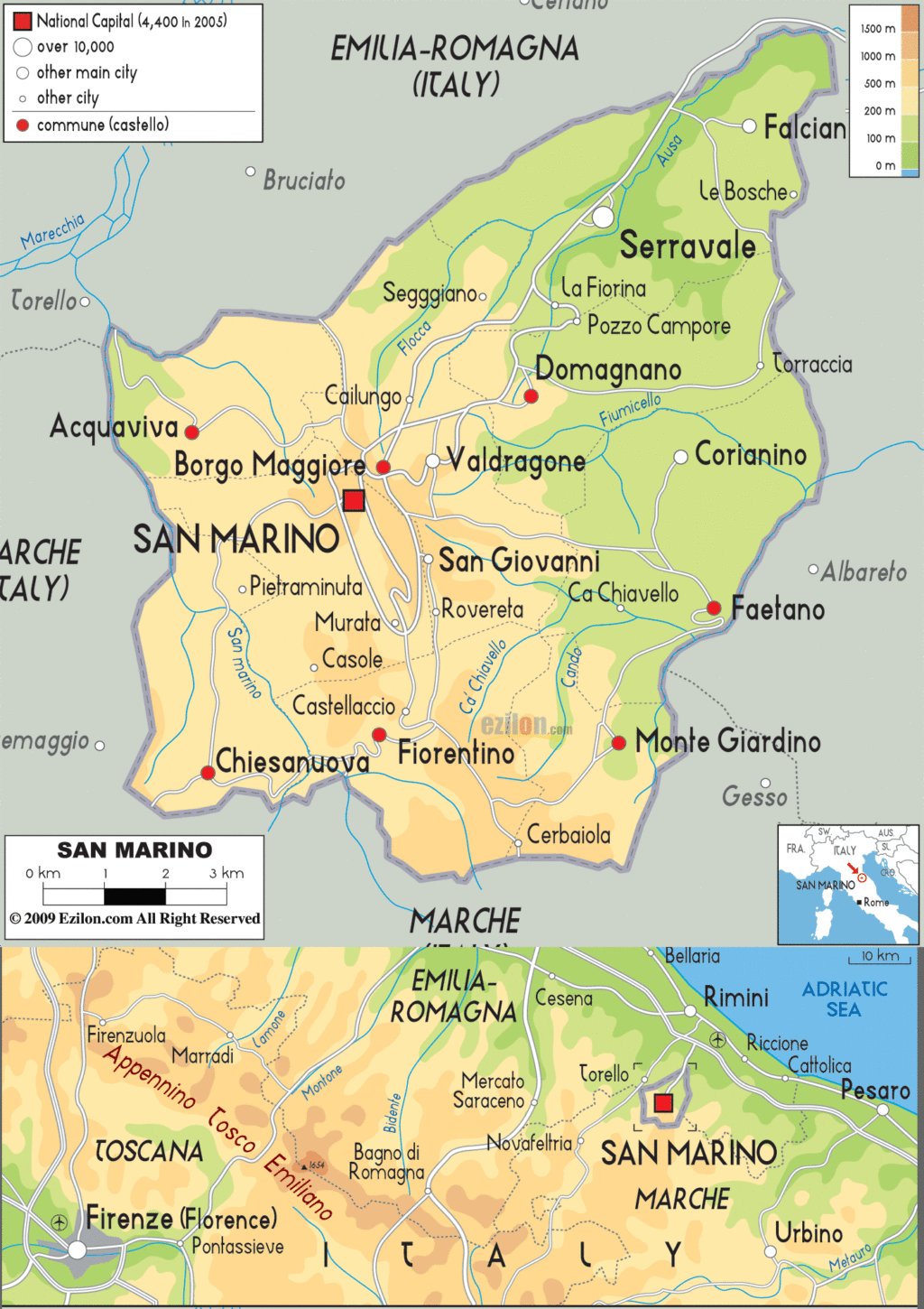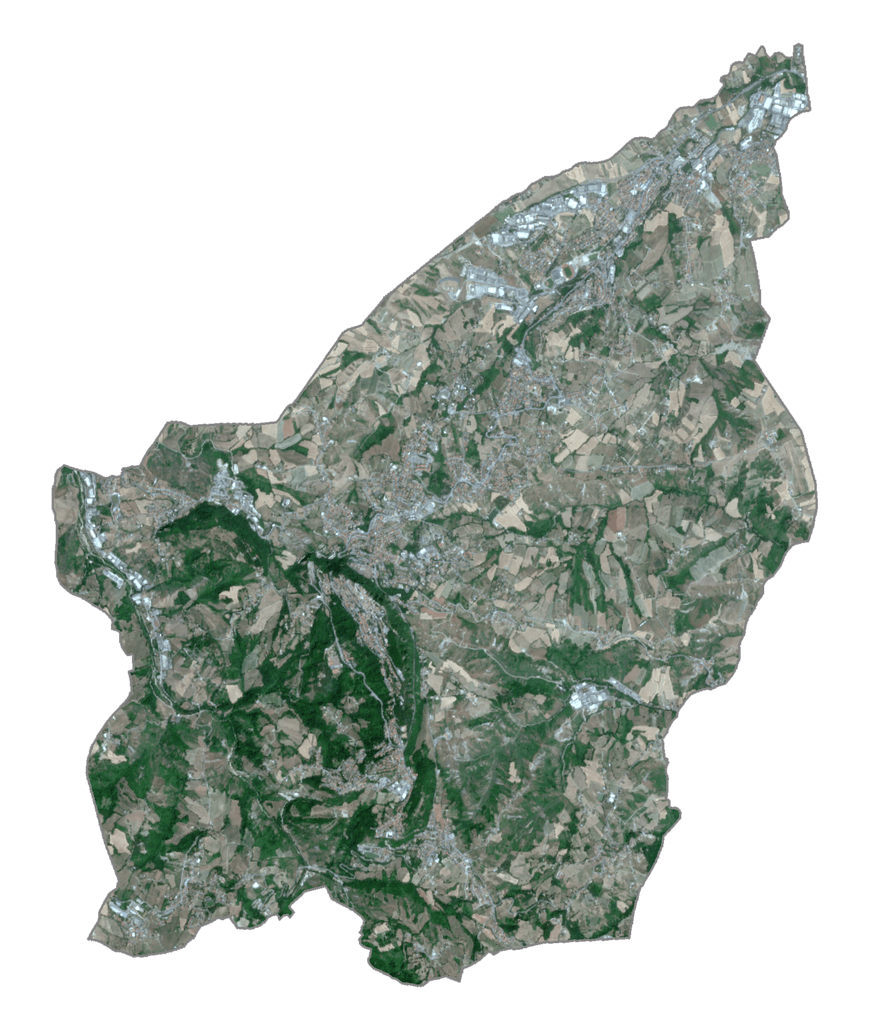With its land area covering only 24 sq miles (61 sq km), San Marino is one of the smallest countries in Europe after the Vatican and Monaco.Landlocked and surrounded by Italy, the country is in the Appennines Mountains region, with most of it on the slopes of Mt. Titano. At 2,477 feet (755 m) Monte Titano is San Marino’s highest point. It has been marked on the map by a yellow upright triangle. Some of the rivers like San Marino River, Fiumicello River, and Ausa River flowing through San Marino have been shown on the map.The lowest point in the country is located in the Ausa River at 55 m.
San Marino is a small, independent republic in the Apennine Mountains of central Italy. It is the oldest surviving sovereign state and constitutional republic in the world, as well as the smallest republic in the world. Its capital city, San Marino, is situated on the slopes of Monte Titano and is surrounded by three towers, which are the symbol of the country. The map of San Marino shows the country’s hilly terrain and its towns, villages, hamlets, rivers, and highways.
The satellite map of San Marino offers a unique view of the country. It shows the hilly terrain, as San Marino doesn’t have much flat ground being part of the Apennine mountain range. The map also shows the three towers which are the symbol of the country, as well as its towns, villages, hamlets, rivers, and highways.
Discover the Unique Topography of San Marino with this Map
Explore the unique topography of San Marino with this detailed map. It includes a satellite map that displays the hilly terrain of the country, as it doesn’t have much flat ground being part of the Apennine mountain range. The map also shows the three towers which are the symbol of San Marino, as well as its towns, villages, hamlets, rivers, and highways. Get a better understanding of the country with this map of San Marino!
Online Interactive Political Map
Click on ![]() to view map in "full screen" mode.
to view map in "full screen" mode.
San Marino (officially, the Republic of San Marino) is divided into 9 municipalities (castelli, sing. castello). In alphabetical order, these municipalities are: Acquaviva, Borgo Maggiore, Chiesanuova, Domagnano, Faetano, Florentino, Montegiardino, San Marino Citta and Serravalle.
With an area of 61 sq. km, San Marino is the 3rd smallest and the oldest independent state in Europe. San Marino is the 5th smallest country in the world. Located on the western side of Monte Titano, is San Marino City (The City of San Marino) – the capital city of San Marino. Dogana is the most populated and the largest settlement of San Marino.
Location Maps
Where is San Marino?
Discover the Tiny, Enclosed Country of San Marino
Nestled within Italy lies a hidden gem – the microstate of San Marino. This tiny country is the fifth smallest in the world, covering only 61.2 square kilometers (23.6 sq mi). Its capital, San Marino City, is located next to the majestic Mount Titan (Monte Titano). The largest settlement of San Marino is Dogana, located in the north. Despite its proximity to one of the most visited countries in the world, San Marino is the least visited country in Europe.
High Definition Political Map of San Marino

History
Saint Marinus left the island of Rab in present-day Croatia with his lifelong friend Leo, and went to the city of Rimini as a stonemason. After the Diocletianic Persecution following his Christian sermons, he escaped to the nearby Monte Titano, where he built a small church and thus founded what is now the city and state of San Marino.
The official founding date is 3 September 301 AD. In 1320, the community of Chiesanuova chose to join the country. In 1463, San Marino was extended with the communities of Faetano, Fiorentino, Montegiardino, and Serravalle, after which the country’s borders have remained unchanged.
In 1503, Cesare Borgia, the son of Pope Alexander VI, occupied the Republic for six months until his father’s successor, Pope Julius II, intervened and restored the country’s independence.
On 4 June 1543, Fabiano di Monte San Savino, nephew of the later Pope Julius III, attempted to conquer the republic, but his infantry and cavalry failed as they got lost in a dense fog, which the Sammarinese attributed to Saint Quirinus, whose feast day it was.
After the Duchy of Urbino was annexed by the Papal States in 1625, San Marino became an enclave within the Papal States, something which led to its seeking the formal protection of the Papal States in 1631, but this never equalled a de facto Papal control of the republic.
The country was occupied on 17 October 1739 by the legate (Papal governor) of Ravenna, Cardinal Giulio Alberoni, but independence was restored by Pope Clement XII on 5 February 1740, the feast day of Saint Agatha, after which she became a patron saint of the republic.
The advance of Napoleon’s army in 1797 presented a brief threat to the independence of San Marino, but the country was saved from losing its liberty by one of its regents, Antonio Onofri, who managed to gain the respect and friendship of Napoleon. Due to Onofri’s intervention, Napoleon, in a letter delivered to Gaspard Monge, scientist and commissary of the French Government for Science and Art, promised to guarantee and protect the independence of the Republic, even offering to extend its territory according to its needs. The offer was declined by the regents, fearing future retaliation from other states’ revanchism.
During the later phase of the Italian unification process in the 19th century, San Marino served as a refuge for many people persecuted because of their support for unification, including Giuseppe Garibaldi and his wife Anita. Garibaldi allowed San Marino to remain independent. San Marino and the Kingdom of Italy signed a Convention of Friendship in 1862.
The government of San Marino made United States President Abraham Lincoln an honorary citizen. He wrote in reply, saying that the republic proved that “government founded on republican principles is capable of being so administered as to be secure and enduring.”
During World War I, when Italy declared war on Austria-Hungary on 24 May 1915, San Marino remained neutral and Italy adopted a hostile view of Sammarinese neutrality, suspecting that San Marino could harbour Austrian spies who could be given access to its new radiotelegraph station. Italy tried to forcibly establish a detachment of Carabinieri in the republic and then cut the republic’s telephone lines when it did not acquiesce. Two groups of ten volunteers joined Italian forces in the fighting on the Italian front, the first as combatants and the second as a medical corps operating a Red Cross field hospital. The existence of this hospital later caused Austria-Hungary to suspend diplomatic relations with San Marino.
After the war, San Marino suffered from high rates of unemployment and inflation, leading to increased tensions between the lower and middle classes. The latter, fearing that the moderate government of San Marino would make concessions to the lower class majority, began to show support for the Sammarinese Fascist Party (Partito Fascista Sammarinese, PFS), founded in 1922 and styled largely on their Italian counterpart. PFS rule lasted from 1923 to 1943, and during this time they often sought support from Benito Mussolini’s fascist government in Italy.
During World War II, San Marino remained neutral, although it was wrongly reported in an article from The New York Times that it had declared war on the United Kingdom on 17 September 1940. The Sammarinese government later transmitted a message to the British government stating that they had not declared war on the United Kingdom.
On 28 July 1943, three days after the fall of the Fascist regime in Italy, PFS rule collapsed and the new government declared neutrality in the conflict. The PFS regained power on 1 April 1944, but kept neutrality intact. Despite that, on 26 June 1944, San Marino was bombed by the Royal Air Force, in the belief that San Marino had been overrun by German forces and was being used to amass stores and ammunition. The Sammarinese government declared on the same day that no military installations or equipment were located on its territory, and that no belligerent forces had been allowed to enter. San Marino accepted thousands of civilian refugees when Allied forces went over the Gothic Line. In September 1944, it was briefly occupied by German forces, who were defeated by Allied forces in the Battle of San Marino.
San Marino had the world’s first democratically elected communist government – a coalition between the Sammarinese Communist Party and the Sammarinese Socialist Party, which held office between 1945 and 1957.
San Marino became a member of the Council of Europe in 1988 and of the United Nations in 1992. It is not a member of the European Union, although it uses the euro as its currency (despite not legally being part of the Eurozone). Before the introduction of the euro, the country’s currency was the Sammarinese lira.
As of June 2020, San Marino had the highest death rate per capita of any country, due to the effects of the COVID-19 pandemic. In April 2021, the nation received headlines for using the Russian Sputnik V COVID-19 vaccine rather than vaccines approved by the EU following a slow rollout for the latter vaccines.
At the 2020 Summer Olympics, San Marino became the smallest country to earn an Olympic medal when Alessandra Perilli won a bronze medal in women’s trap. They later won another medal, this one silver, with Perilli’s and Gian Marco Berti’s performance in the mixed trap shooting event.
On 7 March 2022, during the Russia-Ukraine War, the Russian Kremlin released a list of countries, via Twitter, which it considered “unfriendly” to Russia. San Marino was included in the list, alongside numerous well known Russian adversaries such as the United States and countries in the European Union. The motivation for including San Marino as an “unfriendly” nation was unclear and gained substantial attention on the Internet.
On 31 August 2022, San Marino officials voted to legalize abortion in the republic, “one of the last European states to have had the procedure outlawed under all circumstances”. 32 members of the legislature approved the bill while 10 abstained and 7 rejected. The public health system is promised to cover the cost of the abortion procedure.
Physical Map of San Marino
Geography
San Marino is an enclave surrounded by Italy in Southern Europe, on the border between the regions of Emilia Romagna and Marche and about ten kilometres (six miles) from the Adriatic coast at Rimini. Its hilly topography, with no substantial naturally flat ground, is part of the Apennine mountain range. The highest point in the country, the summit of Monte Titano, is 749 m (2,457 ft) above sea level; the lowest, the Ausa River (ending in the Marecchia), is 55 m (180 ft). San Marino has no still or contained bodies of water of any significant size.
It is one of only three countries in the world to be completely enclosed by another country (the others being Vatican City, also enclosed by Italy, and Lesotho, enclosed by South Africa). It is the third smallest country in Europe, after Vatican City and Monaco, and the fifth-smallest country in the world.
The terrestrial ecoregion of Italian sclerophyllous and semi-deciduous forests lies within San Marino’s territory. The country had a 2019 Forest Landscape Integrity Index mean score of 0.01/10, ranking it last globally out of 172 countries.
Climate
San Marino has a humid subtropical climate (Köppen climate classification: Cfa), with some continental influences. It has warm to hot summers and cool winters, typical of inland areas of the central Italian Peninsula. Precipitation is scattered throughout the year with no real dry month. Snowfalls are common and heavy almost every winter, especially above 400–500 m (1,300–1,600 feet) of elevation.
